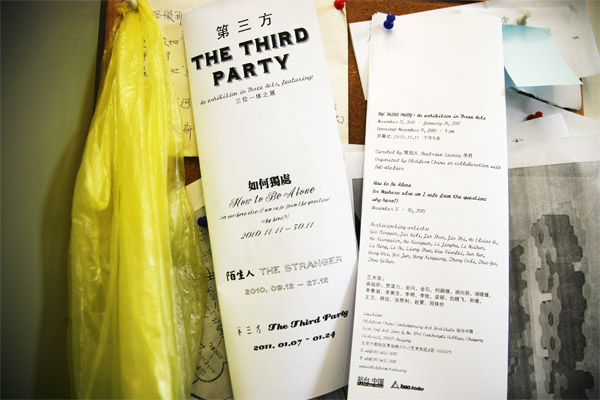Artists: Gao Mingyan, Jia Aili, Jin Shan, Jin Shi, Ho Elaine W., Hu Xiangqian, Hu Xiaoyuan, Li Jinghu, Li Naihan, Li Ming, Li Mu, Liang Shuo, Qiu Xiaofei, Sun Xun, Wang Wei, Yan Jun, Yang Xinguang, Zhang Enli, Zhao Yao, Zhou Yilun.
The Third Party is an exhibition conceived to unfold in three consecutive sessions in Platform China project space. Each approximately lasting twenty days, the three moments of this show are devised to disclose their conceptual and thematic associations as in a chain-reaction, where the individual frameworks are determined by the critical inputs presented within a preceding one.
The Third Party explores the shaping relationships between narrative and aesthetic objects to foreground an inquiry in the realm of the ‘ordinary’ specific to the Chinese context. It does so by mobilizing overarching frames of reference and critique currently at play, be those aesthetic or historical, through three analytical environments tackling respectively issues of self-historicization, witnessing/archiving and collaboration.
The ‘ordinary’ is here awakened to create a momentous connection between aesthetic or artistic acts and the spatial and social conventions characteristic of the local environment as they meet in a dynamic arena of indescribable collusion, an intermediate dimension lingering between art and life in a “luxurious confusion of sense and sensation, of ideas and somatic registering” (Ben Highmore, “Ordinary Lives”). The Third Party focuses on the structures of narration deployed throughout the process of observing, reflecting on the world around us while simultaneously creating it, drifting along the pathways of subjectification and participation in a continuous commitment to “a world in solution (and dissolution), a commitment to the heuristic, prespecialized gestalt of life” (B. Highmore).
It therefore concerns itself with matters of mapping, the tracing of patterns of both presence and absence and the ideological constitution of subjects.
The exhibion is visually designed to present the works of the indivudual artists as self-pronounced archival displays. While each act features a different group of artists, some of the works will varingly evolve in the course of the three months or come to completion at an arbitraty moment in time.
Responsive to the idea of the exhibition as a ‘field report’, the special architectural installation called The Beehive devised by Li Naihan, is constituted by units of exagonal cardboard boxes variously repurposed to be adopted and adapted according to the works.
This project continues an ongoing series of practical and theoretical investigations initiated by the curator Beatrice Leanza, which take the ‘question of space’ at their heart to evaluate its implication with processes of artistic production and representation that inform, both historically and conceptually, specific cultural perception of the contemporary.
Titled “States of Distraction” this series of projects particularly focuses on the interrelation between spatiality and artistic practices from contemporary Asia. It started in November 2009 with the group exhibition “Emporium – A New Common Sense of Space”, presented in Milano’s Da Vinci Musuem of Science and Technology with 27 artists, collectives and independently-run art spaces from China, Korea and Japan.
Act 1:
HOW TO BE ALONE
(or nowhere else am i safe from the question: why here?)
November 11 – 30, 2010
Participating artists: Gao Mingyan, Jia Aili, Jin Shan, Jin Shi, Ho Elaine W., Hu Xiangqian, Hu Xiaoyuan, Li Jinghu, Li Naihan, Li Ming, Li Mu, Liang Shuo, Qiu Xiaofei, Sun Xun, Wang Wei, Yan Jun, Yang Xinguang, Zhang Enli, Zhao Yao, Zhou Yilun.
“Perhaps one of the strongest models of presumed disjunction between everyday life and art, […] is presented in the invisible social space of reading and writing, a space defined temporally and spatially as outside and above the quotidian” (Susan Stewart, “On Longing”).
With no precise point of origin, this journey through the regions of the ordinary draws itself by all manners of distantiation, through acts of arbitraty undoing or unframing of the seemingly perpetual ‘ongoingness’ of the real world.
Like the book written by Jonathan Frenzen from which it takes its title, the exhibition How to Be Alone is not a work of fiction. The ‘chapters’ that constitute it establish connections with the ‘local particulars’ of life in the present in the shape of very personal, provisional solutions or supplementary offerings to its spectacular overabundance of images, hegemonizing ideologies and policing strategies of communal exhistence. As the realm of the social grows overpopulated with the diversification of values and increasingly fractured throughout its cultural ephemera and material networks, ever more intricate and less tangible become the spaces for active participation, more subtle, immediate and intimate our strategies to survive within.
This first exhibition, as well as its second and third iteration, predicate themselves on a simple equation: one that matters the relationship between self and other, the creation of personal, isolated worlds that at the same time concern ‘me’ and ‘us’ as they provide a visual and material repository of contemporary history supplementary to the one offered in the public discourse of master narratives . It is ultimately, in the words of Frenzen, “the problem of preserving individuality and complexity in a noisy and distracting mass culture: the question of how to be alone”.
The works presented in How to Be Alone are differently accompanied by texts and documentation provided by the artists whenever they felt it compelling to tighten the lirical hyphen subtending the relationship between self and (-) history, and therefore self and work.
Artists Wang Wei, Zhang Enli and Elaine W. Ho have realized projects especially for the show, while The Beehive, a special architectural installation designed by Li Naihan, will be rearranged and repurposed during the development of the entire show, along its three consecutive acts.
